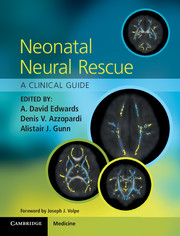Book contents
- Frontmatter
- Contents
- List of contributors
- Foreword
- Section 1 Scientific background
- 1 Neurological outcome after perinatal asphyxia at term
- 2 Molecular mechanisms of neonatal brain injury and neural rescue
- 3 The discovery of hypothermic neural rescue therapy for perinatal hypoxic–ischaemic encephalopathy
- 4 Clinical trials of hypothermic neural rescue
- 5 Economic evaluation of hypothermic neural rescue
- Section 2 Clinical neural rescue
- Section 3 The future
- Index
- References
5 - Economic evaluation of hypothermic neural rescue
from Section 1 - Scientific background
Published online by Cambridge University Press: 05 March 2013
- Frontmatter
- Contents
- List of contributors
- Foreword
- Section 1 Scientific background
- 1 Neurological outcome after perinatal asphyxia at term
- 2 Molecular mechanisms of neonatal brain injury and neural rescue
- 3 The discovery of hypothermic neural rescue therapy for perinatal hypoxic–ischaemic encephalopathy
- 4 Clinical trials of hypothermic neural rescue
- 5 Economic evaluation of hypothermic neural rescue
- Section 2 Clinical neural rescue
- Section 3 The future
- Index
- References
Summary
Introduction
Health care economic evaluation is the study of how the inputs of health care activities, such as medicine or physician labour, affect output, where output is a measure of health status. The aim of economic evaluation is to inform decision makers as to the best, i.e., most efficient, allocation of scarce health care resources with a view to optimizing value for money. Implicit in these definitions is the idea of choice: health care resources are scarce and choices between interventions or programmes are necessary because not all desired outputs can be achieved given constrained health care budgets. Economic evaluation does not, therefore, investigate an intervention in isolation; it is a comparative exercise that examines the costs and consequences of possible decisions between multiple courses of action.
The focus of this chapter is to review the methods used and evidence informing the economic costs and consequences of hypothermia for neonatal rescue. The chapter will begin by providing an overview of the study designs, economic methods and approaches to incorporating statistical uncertainty that are available when conducting an economic evaluation where the patient group of interest is young children. This will be followed by a summary and critique of published economic evaluations that have examined resource allocation issues surrounding inducing hypothermia in children with encephalopathy. The final section will highlight significant differences between the identified studies and will critically discuss the effects alternative assumptions have on the study conclusions.
- Type
- Chapter
- Information
- Neonatal Neural RescueA Clinical Guide, pp. 53 - 64Publisher: Cambridge University PressPrint publication year: 2013

